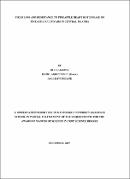| dc.description.abstract | Pineapple (Ananas comosus (L.) Merr) is of tremendous importance as a fruit crop in Uganda.
However, production in Uganda is currently threatened by outbreaks of pineapple heart rot
disease (PHRD). PHRD is the most widespread and devastating disease of pineapple in Uganda
and can cause tremendous yield loss. Although, some preliminary information exists on PHRD
in Uganda, the yield loss attributed to the disease has not quantified neither is there any
information on sources of resistance. The objective of this study was, therefore, to determine
yield loss and resistance to pineapple heart rot disease in central Uganda. In order to address
these objectives, five cultivars of pineapple were planted in the screen house and in the field in a
completely randomized design (CRD) and randomized complete block design (RCBD),
respectively. Treatments on yield loss assessment consisted of protected plot, un-protected plot
and control plot respectively. Pineapple plants in the protected plots had their suckers dipped for
three minutes in a solution of Metalaxyl (Active Ingredients: methoxyacetyl)-N-(2, 6-xylyl)-DLalaninate
8%) before planting and later sprayed with a solution of Fosetyl Al (Active Ingredients:
Aluminum trees 80%) using a backpack sprayer with Hardir flat spray nozzles three weeks after
planting. Pineapple plants in the un-protected plots were not treated with any fungicide. The
suckers were inoculated with 108m1 of zoospores using needle-mediated leaf base wound
technique. Treatments on resistance consisted of five cultivars of pineapple (Smooth Cayenne,
Victoria, Sasilimu, MD-2 hybrid and Red Spanish) Planted in a field with a history of PHRD
infestation. Results from the screen house study indicated100% yield loss in all five cultivars
after two months. Field experiments indicate that all the five cultivars used were susceptible to
PHRD although Smooth cayenne showed moderate resistance to PHRD. Additional studies,
therefore, need to be conducted using more pineapple cultivars to establish their suitability as
genetic material in breeding for resistance against PHRD and to minimize yield loss. | en_US |

